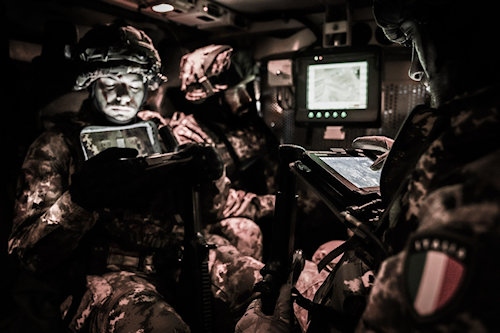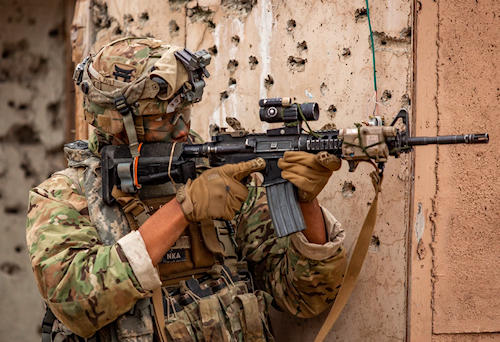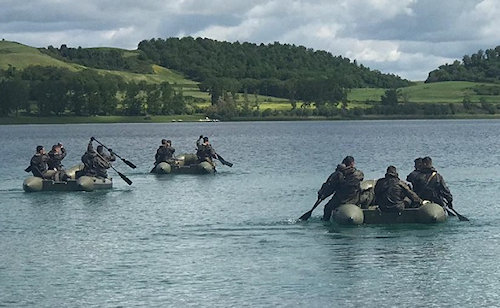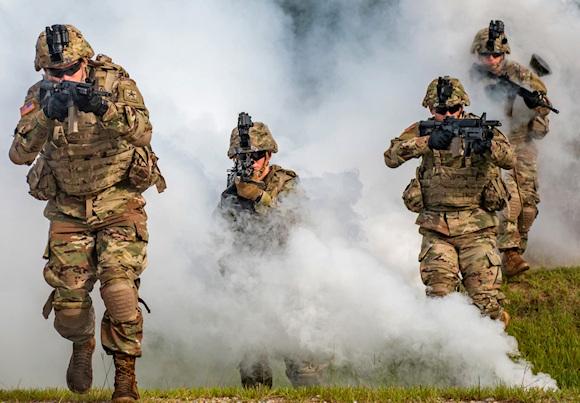La Game Theory it is the most used analysis and forecasting tool (military, geopolitical, business) in the world, and allows you to simulate conflict and/or crisis situations in measurable terms (also mathematically), for which solutions can therefore be sought through pre-defined models. demonstrable. It also offers a prospective vision, which shows how decisions - according to a mechanism defined as feedback - must estimate a gain that is as shareable as possible, which turns out to be (almost) always the best result, in practical and strategic terms.
Il video lesson also shows a beautiful example of teamwork: "doing what is best for oneself and for the group" is the true dogma of Team Working.
“There are 3 ways of doing things: the right way, the wrong way and the military way”
The military way is the one that offers the best effectiveness-efficiency ratio. It is used to quickly and precisely know how, when, who to do what (obviously including us), and how born to face the most terrible thing that human beings have ever had to handle since they began to live in organized communities: war.
History has shown that some organizational problems - not only in the field of war (the Panama Canal, for example) - have foreseen and increasingly foresee the use of personnel and structures conceived and developed in the military field (another example: the management of the vaccination campaign against Covid19, under the command of an Alpine general who is a veteran of Afghanistan, logistics expert). Armed Forces personnel are also called upon to guarantee public safety, support civil structures in case of emergency (of any kind), provide "intelligence" to commercial and financial structures, wherever required, using technical skills militar, and much more.
 The modern military structure, understood as a orderly set of personnel and equipment designed to prepare and carry out defensive and/or offensive actions in the event of conflicts, can be historically traced back to King Philip of Macedon, father of the greatest military commander in history, Alexander the Great.
The modern military structure, understood as a orderly set of personnel and equipment designed to prepare and carry out defensive and/or offensive actions in the event of conflicts, can be historically traced back to King Philip of Macedon, father of the greatest military commander in history, Alexander the Great.
Philip and Alexander, with the extraordinary use of the phalanx and cavalry, demonstrated how an army, even much smaller than the enemy (the Persians), could conquer much of the then known eastern world in just 12 years.
The army was to be:
• hierarchically structured in a clear and precise way;
• based on a coherent and correctly indicated discipline;
• well trained and prepared to carry out assigned tasks, expert in the use of his/her equipment;
• confident of their officers, always ready to lead by example, well supplied and rewarded, aware and informed of the importance of the mission.
We will return to Alessandro and his being an extraordinary leader, recognized by all as such not by dynastic right, but for his own virtues and abilities.
 But now let's discover the 4 pillars of teamwork, as valid now as they were then.
But now let's discover the 4 pillars of teamwork, as valid now as they were then.
Hierarchy: the people who at every level compose and manage a command and control structure in order to guarantee the carrying out of the actions decided in an orderly manner.
Discipline: the rules that regulate the tasks and actions of a community and their sharing and observance.
Training: the acquisition of particular physical, intellectual and technical skills, through pre-established exercises and studies and/or suggested by experience.
The resultant of these three "vectors" will lead to Motivation, of which a more detailed definition will follow later.
Understanding and using the 4 pillars of teamwork means first knowing the position one occupies on the field (battle, play, work...) and along a hierarchical line. In other words, and more pragmatically, the place where you live and work is today also a virtual, social and therefore multidimensional space. Knowing ourselves therefore, our limits, but above all our abilities. Know the environment around us in detail, and make the best use of the main assumption of Game Theory: doing the best for oneself and for others, knowing that this more than anything else will make ours the winning team.
The concept, in itself, is valid in every scenario: having situational awareness means being able to control events, managing in the best way for us and for everyone, placing ourselves in the most favorable position and therefore having an advantage in the space-time context in which we will find ourselves operating.
This ability is called Situation Awareness, a concept developed by the USAF during the 2a World War, processing the mission data of the air flocks as a whole, not just combat therefore, of departments such as logistics, maintenance, personnel, healthcare, administration, intelligence...
 Very valid and still used today, it has the result of describing as the winner, in an aerial duel (or in carrying out a mission of any type and nature) the pilot and the crew who will have perfect control of the tactical situation in which they comes to find, who will know exactly where he is in the space-time mission, and that he knows where all the other actors on the field are at that specific moment (not just the "enemy" then). He knows where the supports are located, which are extremely important and must also be considered as precious control tools, which can also be decentralized with respect to our operational structure, such as logistics departments, intelligence and listening/information collection centers (but also data base e software specialist both internal and external, increasingly relevant). We'll talk about it again Situation Awareness, of one of the figures who developed it, of his "Art of Command": Gen. Curtis Le May.
Very valid and still used today, it has the result of describing as the winner, in an aerial duel (or in carrying out a mission of any type and nature) the pilot and the crew who will have perfect control of the tactical situation in which they comes to find, who will know exactly where he is in the space-time mission, and that he knows where all the other actors on the field are at that specific moment (not just the "enemy" then). He knows where the supports are located, which are extremely important and must also be considered as precious control tools, which can also be decentralized with respect to our operational structure, such as logistics departments, intelligence and listening/information collection centers (but also data base e software specialist both internal and external, increasingly relevant). We'll talk about it again Situation Awareness, of one of the figures who developed it, of his "Art of Command": Gen. Curtis Le May.
Hierarchy
When entering a mission context (as in any organized structure), the first thing to do will be to position ourselves correctly along the existing command and control structure, clearly understanding who our contacts are positioned further ahead, at our sides, at the behind us (and/or higher, lower, to the side) in order to guarantee the flow of information (by far the most important thing to take into account) to reach us correctly and quickly, allowing us to carry out the task assigned in a coherent, verifiable way and, not least, to check in turn that everyone is doing the same. Basically it is a question of knowing who to ask what and to whom to transmit the information of the successful (or non-compliant) execution, in carrying out our task.
 I would like to underline it again: the fulcrum of our operations will therefore be to know one's position on the "battlefield", in the deployment (or within a company organization chart, in a logistics chain, etc.).
I would like to underline it again: the fulcrum of our operations will therefore be to know one's position on the "battlefield", in the deployment (or within a company organization chart, in a logistics chain, etc.).
Discipline
It is the precise knowledge of the rules, be they technical, behavioral, legal, regulatory, and of their practical and theoretical application. If, to a less attentive eye, it may initially seem like a constraint, a boundary, on the contrary it is a powerful tool available to all the resources in the field. Knowing exactly the general and/or specific parameters of the mission, being able to calibrate one's actions based on these by verifying their common sharing, once again allows one to control and correctly balance one's initiatives and actions, keeping in mind all aspects and actors in and on the field, to be implemented if possible always keeping in mind the initial dogma: "Do what is good for us and for others". Furthermore, knowing the rules and applying them consistently ensures "operational stability", as everyone will always know where everyone else is in relation to their task.
From the platoon to the army, the advance must be balanced and compact, disciplined: there must be no stronger or weaker points along the front line: inconsistent peaks of offensive courage, as well as defensive excesses and/or "indecisions". If it is well thought out, it will be enough to establish its rhythm, calibrated on our abilities and will (and not on those of others), making sure that everyone respects its "cadence". One of the most deadly mistakes that we tend to commit, in the military field but not only, is to lean too far forward, finding ourselves without realizing it fighting on the opponent's terrain, that is, the one chosen by him, and not on our own. more favorable. I suggest close attention in this regard.
 Discipline also means understanding a modus operandi based on its own principles, which certainly include the desire to achieve a result with courage and determination, but always in compliance with the rules.
Discipline also means understanding a modus operandi based on its own principles, which certainly include the desire to achieve a result with courage and determination, but always in compliance with the rules.
Training
Training means being ready and prepared to carry out your job and/or a specific mission when you are called to do so. Nothing more, nothing less.
In complex and variable scenarios like the current ones, it is understood that "being ready" is perhaps the most important part of one's role. Keeping yourself updated in an organized and methodical way will allow you to carry out your task and then also the specific mission using an established, tested, shared (we could even say a routine) operating procedure, without stress, ready to adapt to any changes in the scenario , which will probably have already been contemplated during the more advanced stages of training.
Being ready therefore, well trained, also means having alternative plans, getting used to thinking in an elastic, fluid way: "be like water, and not like the vessel that contains it".
And again: correct and constant training also allows you to choose the time, way and place of the challenge, and not to suffer the choice. I underline once again that the soldier makes his training the fulcrum on which his operations hinge.
"We answered a call, we applied, we were selected, we passed some tests, we were given a job (which usually takes into account studies, acquired experiences, our personal abilities and aptitudes, and also, although not always, our desires and expectations)".
 Let's admit here that we have already undergone basic training. Once you have arrived at the department and the relevance has been assigned, a new specific training will begin. It may be that you arrive there with your own experience and even with your own "tactical" data, or you may also be called upon to reorganize an existing structure.
Let's admit here that we have already undergone basic training. Once you have arrived at the department and the relevance has been assigned, a new specific training will begin. It may be that you arrive there with your own experience and even with your own "tactical" data, or you may also be called upon to reorganize an existing structure.
From personal experience, it will always be preferable to start again from the "historical" characteristics, absorbing the past experiences. In this way, important credits are acquired and valuable relationships are established in a reasonably short time.
I would like to remind you of something of fundamental importance, which must be well interpreted and understood: I volunteered for my operations department, it was my choice, I was given the opportunity to be part of it. I wasn't forced. This, in my opinion, should always be taken into account when thinking about one's role and work. And it applies to everyone. Postulate: If we think that pulling the trigger of an assault rifle is a soldier's raison d'etre, and therefore the Reason to train, I can guarantee that we are starting off on the wrong foot.
Unless the act itself is the phase of a process and/or of a study program and long and complex exercises, it will be for everything that happens before fighting that we must train: controlling and managing the situation or crisis does not during the battle, but possibly anticipate it. And here we return to "situational awareness".
"The greatest victory is the one achieved without fighting." History teaches us that this, more than any other, would always be the way forward.
 Motivation
Motivation
I would like to talk to you about Gen. Dwight Eisenhower, the strategist of the Normandy landings. On the afternoon of 5 June 1944 the general wanted to meet the paratroopers who were about to embark and then launch themselves, at night, into the hinterland of Normandy: by far the most complex and potentially dangerous military operation in history, which was also carried out in an operational time very short.
Eisenhower was literally shaking with fear that day. It took him an enormous effort and an iron will not to show his doubts and fears of him, while he joked and shook hands and patted those young soldiers on the back. All volunteers, efficiently staffed, superbly trained and well equipped, correctly informed of their duties and mission and, perhaps most important of all, extraordinarily motivated (for those who want to learn more: "Why we fight" US Armed Forces document given to soldiers upon enlistment).
The general (who looked more like a literature professor, but who inside had a determination as hard as steel, aimed at winning even against the adverse natural events of those days) knew that there was a concrete possibility that the losses among those young soldiers could have even reached 70%, that is, out of 10 of those kids, 7 could have fallen within the first 48 hours of launch. It was a fact that terrified him, intimately.
I repeat the forecast data on possible losses: 7 lost out of 10 launched, within the first 48 hours. Let's think about it for a moment... what made those young soldiers get on the planes, and what made an intelligent and rational man like Eisenhower (who later became president of the United States for 2 terms) decide to ask them, to order them to board? A clear, structured, built "Motivation"!
The path, the best path, that those young men took on the day they volunteered for the parachute corps had come to motivate them to such an extent that they felt ready and determined to jump from a plane, at night, in one of the most lethal in the world. The 4 pillars of teamwork had evidently been "built" well.
Eisenhower was wrong: the losses, in September 1944, among those boys were "only" between 30 and 40%: 3/4 out of 10.
I say that those boys had already won their war the very day they became paratroopers, introduced themselves to their officers, shook hands with each other and became an elite fighting unit.
If you can feel the quiet and simple power of this fact, then you have an understanding of the concept of "Motivation." And even though the context is unfavorable to you, the road is uphill, victory seems distant, if you return to the 4 pillars, together, you will find a way to regain the initiative, to relaunch. And this makes and will always make the difference.
Photo: U.S. Army / web / U.S. Navy / U.S. Air Force / Italian Army












